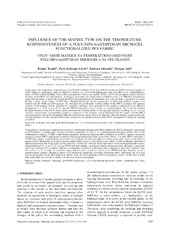Приказ основних података о документу
Influence of the matrix type on the temperature responsiveness of a poly-nipaam/chitosan microgel functionalized pes fabric
| dc.creator | Tomsić, Brigita | |
| dc.creator | Lavrić, Pavla Krizman | |
| dc.creator | Simončič, Barbara | |
| dc.creator | Jocić, Dragan | |
| dc.date.accessioned | 2021-03-10T11:58:39Z | |
| dc.date.available | 2021-03-10T11:58:39Z | |
| dc.date.issued | 2013 | |
| dc.identifier.issn | 1580-2949 | |
| dc.identifier.uri | http://TechnoRep.tmf.bg.ac.rs/handle/123456789/2260 | |
| dc.description.abstract | In this paper, the temperature responsiveness (swelling/de-swelling) of the poly-NiPAAm/chitosan (PNCS) microgel applied to a PBS fabric in combination with two different matrixes, i.e., 1,2,3,4-butanetetracarboxylic acid (BTCA) or vinyltrimethoxysilane (VTMS) with hydrophilic fumed-silica nanoparticles (SiO2) was studied. While a BTCA-based matrix enables chemical bonding of the PNCS microgel particles, resulting in a formation of a rigid surface-modified system, a VTMS/SiO2 polysiloxane matrix has the ability to physically entrap the PNCS microgel particles and stimulate, due to its elasticity, a formation of a more flexible coating on the surface of PES fibres. Morphological and chemical properties of differently finished samples were studied with the SEM and XPS analyses. To determine the swelling/de-swelling ability of the PNCS microgel, the moisture contents of the samples, before and after five repetitive washings, were obtained for the samples conditioned at two different temperatures, i.e., at 25 degrees C and 40 degrees C, when the PNCS hydrogel was in its swollen or collapsed phase. The results showed that the rigid structure of the BTCA-based matrix restricted the swelling ability of the microgel particles, resulting in a 12 % lower moisture content of the corresponding sample in comparison to the moisture content determined for the sample with the PNCS microgel particles physically entrapped within the polysiloxane matrix. Due to its elasticity, the polysiloxane matrix enables the microgel particles to fully expand, which is the consequence of a partial removal of the PNCS microparticles during the washing procedure. | en |
| dc.publisher | Institute of Metals and Technology | |
| dc.rights | openAccess | |
| dc.source | Materiali in Tehnologije | |
| dc.subject | hydrogel | en |
| dc.subject | microgel | en |
| dc.subject | poly-NiPAAm/chitosan | en |
| dc.subject | 1,2,3,4-butanetetracarboxylic acid | en |
| dc.subject | vinyltrimethoxysilane | en |
| dc.subject | responsiveness | en |
| dc.title | Influence of the matrix type on the temperature responsiveness of a poly-nipaam/chitosan microgel functionalized pes fabric | en |
| dc.type | article | |
| dc.rights.license | ARR | |
| dc.citation.epage | 619 | |
| dc.citation.issue | 5 | |
| dc.citation.other | 47(5): 615-619 | |
| dc.citation.rank | M23 | |
| dc.citation.spage | 615 | |
| dc.citation.volume | 47 | |
| dc.identifier.fulltext | http://TechnoRep.tmf.bg.ac.rs/bitstream/id/591/2257.pdf | |
| dc.identifier.pmid | ||
| dc.identifier.rcub | https://hdl.handle.net/21.15107/rcub_technorep_2260 | |
| dc.identifier.scopus | 2-s2.0-84887208917 | |
| dc.identifier.wos | 000326005900012 | |
| dc.type.version | publishedVersion |

